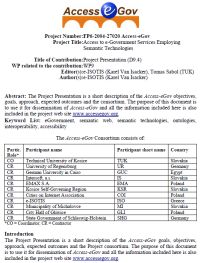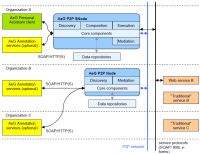By employing semantic technologies the Access-eGov project supports semantic interoperability among e-government services across organisational, regional and linguistic borders. For service providers (on all levels of public administration - local, regional, national, and European) Access-eGov enables introduction of a (new) e-service to the world of e-government interoperability in an easy way. The government service registered in the Access-eGov may be localised, contracted and used automatically through agents and other IT components. more...
See the Project Presentation outlining key facts on Access-eGov:
 |
Access-eGov is built on peer-to-peer and service-oriented architecture, addressing the semantic issues through ontology-guided mark-up of local e-government service interfaces.
Component-based security infrastructure provides a complete portfolio of necessary security services (authentication, authorisation, attribute management, access control, data protection, auditing) that are accessible through web service interfaces. more...
Download the DELIVERABLE describing the Access-eGov architecture:
 |
Access eGov project can help you:
- To improve accessibility and connectivity of governmental services for citizens and businesses.
- To simplify the use of government services for users - by means of creating integrated hybrid scenarios and providing guidance to users while following this scenario. How?
In “real life” situations citizens as well as businesses usually do not need an atomic (singular) government service, but a (often non-linear) sequence (including if-then-else branches) – it means “scenario” of atomic services. And since we are still far away (especially in the NMS) from the situation that all needed government services for the given life event are available on-line, it means that users usually have to deal with a combination of traditional services and e-services. more...
|



